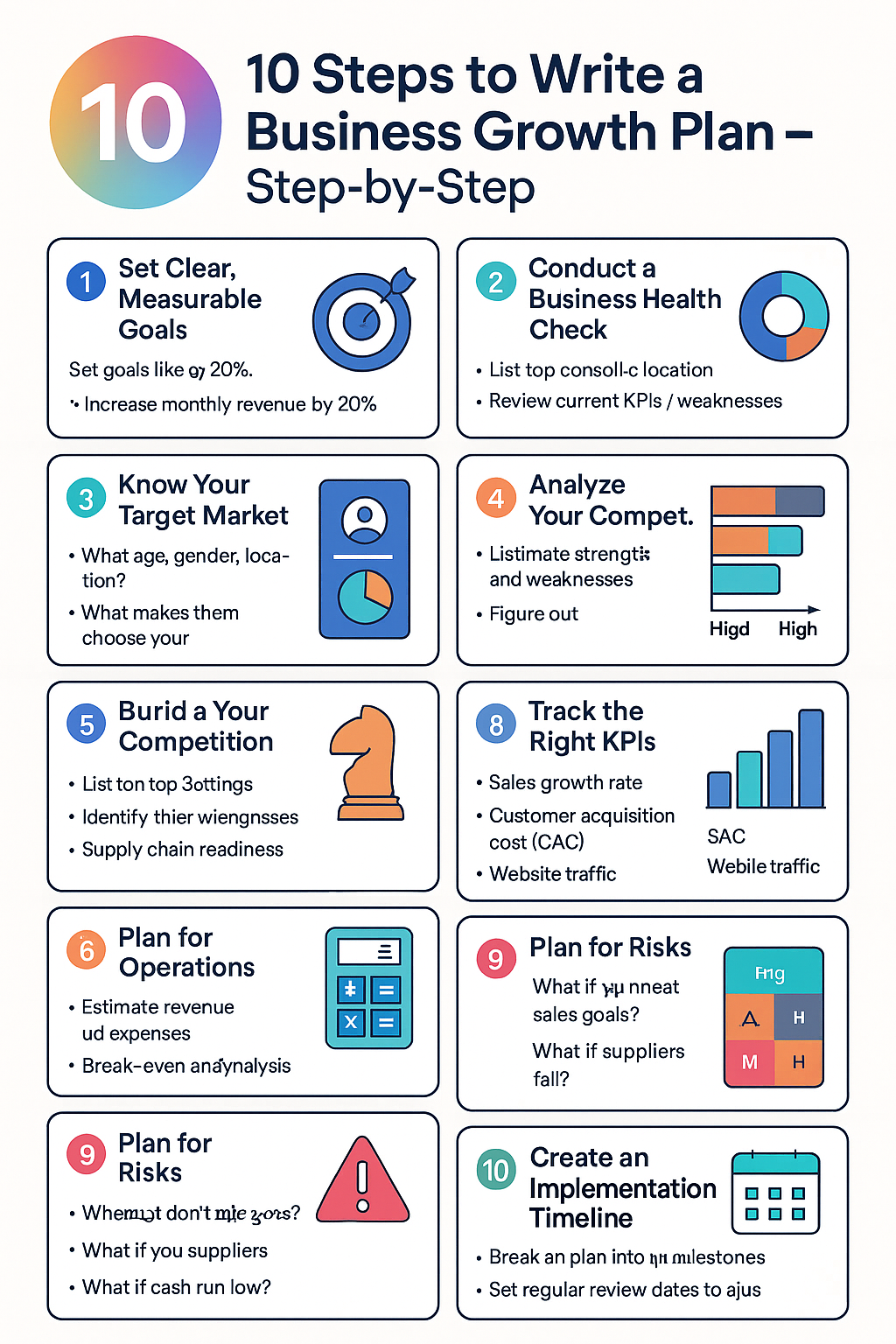At Business Growth Point, we focus on what really matters — practical strategies, real-world examples, and proven tactics to grow your business.
Most businesses hit a wall at some point. Sales slowdown. Customers stop coming in like they used to. What usually causes that? A lack of direction.
That’s where a Business Growth Plan comes in. It’s not just a buzzword. It’s a clear roadmap to help your company move forward with purpose, strategy, and results.
Whether you’re just starting out or ready to scale, this guide will show you how to build a growth plan that actually works—without the fluff.
Table of Contents
What Is a Business Growth Plan?
A Business Growth Plan is a structured document that outlines how your business will grow over time. It includes your goals, target market, marketing strategy, operations, and financial forecasts.
How it’s different from a regular business plan:
- A business plan focuses on launching or running your business.
- A growth plan focuses on expanding it—more customers, more revenue, more reach.
Why a Business Growth Plan Matters
- Strategic direction: It gives you a path, not just a wish list.
- Investor confidence: Funders want to see a plan before they invest.
- Scalability: You can’t grow what you don’t measure or manage.
Who should use this guide:
- Startups looking to grow their footprint
- Small and medium businesses scaling up
- Entrepreneurs who need a structured approach to expansion
What Goes Into a Business Growth Plan?
Think of it like building a house—you need a blueprint. Your growth plan should include:
- Clear goals
- Marketing strategy
- Financial forecasts
- Operational plans
- Key metrics to track progress
Benefits of a Business Growth Plan
Having a growth plan gives your business a serious edge:
- Helps prioritize what really matters
- Attracts investors, banks, and partners
- Keeps your team aligned and focused
- Reveals new growth opportunities
- Lowers risk by planning ahead
10 Steps to Write a Business Growth Plan – Step-by-Step
1. Set Clear, Measurable Goals
Your goals should be specific and trackable. Avoid vague statements like “grow sales.”
Instead, aim for goals like:
- Increase monthly revenue by 20% within 6 months
- Launch 2 new products by Q4
- Grow customer base by 1,000 in 12 months
Use the SMART goal framework (Specific, Measurable, Achievable, Relevant, Time-bound).
2. Conduct a Business Health Check
Before you grow, you need to know where you stand.
- Do a SWOT analysis (Strengths, Weaknesses, Opportunities, Threats)
- Review current KPIs (Key Performance Indicators)
- Get customer feedback to find improvement areas
- Identify any operational bottlenecks slowing you down
3. Know Your Target Market
Understanding your ideal customer is key.
- What age, gender, or location are they in?
- What are their needs or pain points?
- What makes them choose your business?
Segment your market and focus on the group that brings the most value.
4. Analyze Your Competition
You can’t grow if you don’t know who you’re up against.
- List your top 3–5 competitors
- Identify their strengths and weaknesses
- Figure out your unique advantage—what makes your business stand out?
5. Build a Marketing & Sales Strategy
Now that you know your customer and competitors, create a solid marketing plan.
- Channels: Social media, SEO, email, events, referrals
- Message: What’s your unique value proposition?
- Budget: Know how much to spend and where
- Funnel: Understand how leads become customers
- Retention: Keep your customers coming back
6. Plan for Operations
Behind-the-scenes work makes growth possible.
- Who will you need to hire?
- What tools or software do you need?
- Are your current systems ready to scale?
- Is your supply chain reliable and scalable?
7. Forecast Your Finances
Money matters. You need to know your numbers.
- Estimate revenue and expenses for the next 12–24 months
- Do a break-even analysis
- Build a cash flow projection
- If you need funding, clearly show how much and why
8. Track the Right KPIs
You need to measure what matters.
Some key KPIs to consider:
- Sales growth rate
- Customer acquisition cost (CAC)
- Customer lifetime value (CLV)
- Website traffic or lead conversion rates
- Net profit margins
Track these regularly and use them to adjust your strategy.
9. Plan for Risks
Growth doesn’t come without risks. Be ready for them.
- What if you don’t meet sales goals?
- What if your suppliers fail?
- What if cash runs low?
Create backup plans and build financial buffers. Flexibility is part of resilience.
10. Create an Implementation Timeline
Don’t just make a plan—act on it.
- Break the plan into monthly or quarterly milestones
- Assign tasks and owners for each step
- Set regular review dates to adjust the plan as needed

Common Mistakes to Avoid
- Avoid these traps that sink growth plans:
- Being too optimistic with numbers
- Ignoring what the market is telling you
- Trying to grow in every direction at once
- Not planning for capacity or resources
- Not tracking key metrics
Helpful Tools & Templates
Make planning easier with the right tools:
- Business Growth Plan template (Google Docs or Word)
- Financial forecast spreadsheet (Excel or Google Sheets)
- SWOT analysis template
- SMART goals worksheet
- KPI dashboard tracker
Real Examples That Worked
Here are a few quick examples:
- A local coffee shop doubled revenue by adding online orders and local delivery—backed by a growth plan with weekly metrics.
- A software startup used a clear growth plan to secure funding, expand to three cities, and grow their user base 10x in 18 months.
- A boutique clothing brand focused on customer retention and email marketing, leading to 40% revenue growth in one year.
FAQs About Business Growth Plans
- How long should a growth plan be?
It can be 5–10 pages. Keep it practical and actionable. - How often should I update it?
Review and revise every 3–6 months. - Can I use it to get funding?
Yes—investors want to see a clear growth path. - Do I need a consultant to help?
Not necessarily. You can start with a good template and get help where needed.
Final Thoughts
If you want your business to grow, you need more than good ideas. You need a Business Growth Plan.
It helps you stay focused, make smart moves, and track your success. Growth doesn’t happen by accident—it’s planned.
Start simple. Take it step-by-step. And remember, action beats perfection.




